Boericke & Tafel – Embossed Homeopathic Apothecary Bottles
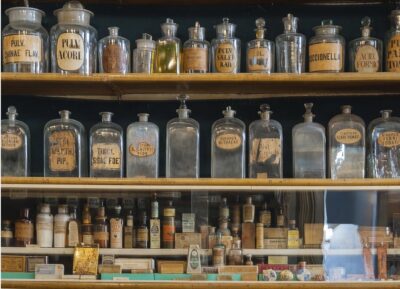
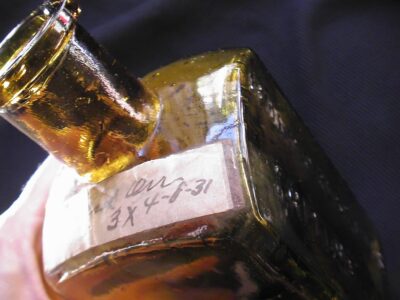
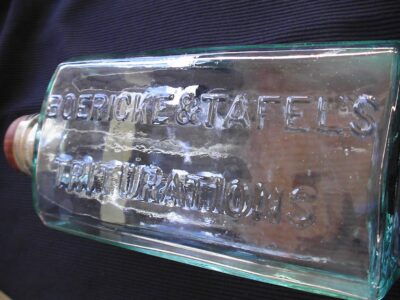
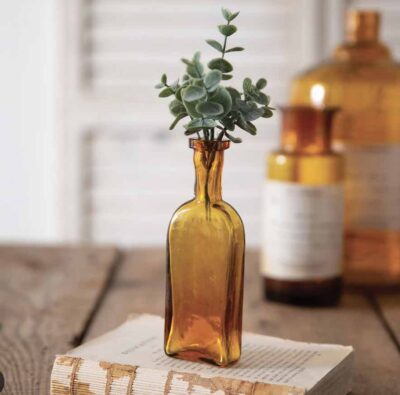
Your own package of homeopathic history is available today!
Bottles are “as is” with original label, contents, and exterior dust! Each one is 8″ tall and 3″ square.
Bottles are free.
You pay pack & ship.
2 Bottle box: $28.45
9 Bottle box: $56.95
Prices here are for US domestic shipping. International shipping – Contact us for cost and invoice. Example international shipping costs per small 2 bottle box:
-
- Canada: $45.40
- UK: $58.50
- Brazil: $67.45
- Japan: $121.30
- Australia: $71.20
Really? These bottles are free (just pay packaging and shipping – $28.45 per box of two bottles / $56.95 per box of 9 bottles – US domestic shipment)
Yes – these bottles, which were held by the California Department of Parks and Recreation – Museum Collections from the 1950s through 2009, are intended to be distributed through the homeopathic community to those who will appreciate their unique history and properly take responsibility for them.
Can I use the remedy contents in these bottles as effective homeopathics?
Not likely. It seems very doubtful that the remedy contents would be viable, but it is impossible to tell for sure. The boxes did sit in warehouses for decades through Sacramento summers in high heat, which would have damaged the potency of the triturated powders.
Are any of the triturated contents in the bottles toxic or dangerous?
Most of the bottles hold inert substances, but there are bottles with low x potencies of toxic minerals, plants and animals (arsenic, mercury, lachesis, naja, pulsatilla, etc). These need to be handled with care. In particular, the remaining content needs to be kept from anyone that might mistakenly ingest it (children, pets), and if bottles are washed, the water with the contents needs to be disposed of properly. All who receive these bottles are accepting stewardship for these artifacts, with appropriate caution and care for bottles and contents.
Is there a limit to how many boxes of bottles I can request?
Nope. Request several, and share them with your study group team, professional colleagues, and family history buffs.
If I request more boxes of bottles, will it reduce my shipping costs?
Nope. The boxes are packed, in sets of two, or in sets of nine, in very sturdy boxes that are specifically designed for protection during mailing. By shipping each box of bottles separately we are assuring safe delivery! The shipping cost is set for each size package.
Can anyone request a pair of bottles?
Yes. Request several boxes, and share them with your study group team, professional colleagues, and family history buffs.
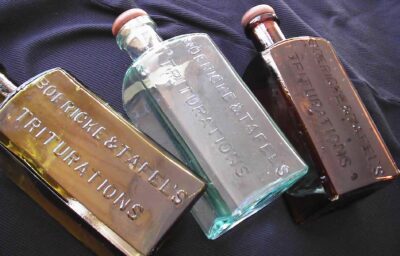
Express thanks is extended to the California Department of Parks and Recreation – Museum Collections for their support of homeopathic history.
History of these bottles…
At Constantine Hering’s suggestion, Philadelphia book store owner Francis Boericke began to manufacture homeopathic remedies for sale in his store in the 1850s. Later, with his young apprentice, Adolph Tafel, Boericke formally founded B&T in1869, America’s oldest homeopathic pharmaceutical company. From their Philadelphia base, they expanded across the country and became the largest homeopathic pharmacy in the U.S.
Druggists used larger bottles as bulk containers to store and dispense bulk powders and liquids. Glass manufacturers called them Shop furniture or Shelf ware. B&T purchased thousands of these bottles for manufacturing use. These were trituration bottles, which held the intermediate substances in the step by step potentization process that created final homeopathic medicines.
B&T eventually closed it’s facilities in Santa Rosa, California, and donated it’s local stock bottles to a small private local museum. The assets were later transferred to the California Department of Parks and Recreation – Museum Collections. These items were held in a warehouse in Sacramento, California until the collection was de-accessioned in 2009. The museum curator contacted various homeopathic organizations, requesting that these bottles be taken in trust to distribute safely and appropriately to the homeopathic community. Pacific Academy of Homeopathy in San Francisco, whose director at the time was Karen Allen, took stewardship of these bottles.
These Bottles are Old… estimated pre-1880 to 1910
Most likely manufactured in series from the same hand blown mold process across decades, the oldest bottles within the collection are dated prior to 1880, and the more recent bottles prior to 1910. The estimated age of the bottles has been derived by review of artifacts of the manufacturing process that are visible in each bottle.
These Bottles are Hand blown…
Bottles require an arch in the base for stability as they sit on a flat surface. The arch’s appearance suggests the manufacture process. The base of each B&T bottle has a circular indentation that is a characteristic result of the ‘post bottom mold’ into which the hot glass has been blown. Post-bottom molds were typical in larger (more than 8 inch height), wider bottles, such as druggist bottles, until the early 1890s. These bottles show the faint reminder of a seam that runs diagonally across the flat part of the base that surrounds the indentation. This can be seen on the base of most (and on the shoulder of some) of the B&T bottles.
See the video at the top of this page for an example of the process.
After the bottle was blown, it was broken away from the pontil (blow pipe) rod. This left a relatively rough edge at the top, which was refined as the glassblower applied a finished ring to the edge. Many of the B&T bottles have this ‘applied finish’. By looking carefully, a seam is clearly visible under the outer edge of the ring as it meets the bottle neck. This suggests that the manufacture of these bottles is prior to 1880.
Some of the B&T bottles have a ‘tooled finish’. After 1890, most manufacturers had developed a method to set the bottle’s lip ring as part of the bottle creation, not an addition at the end. In these B&T bottles, the lip ring can be seen to be continuous with the bottle, with a slightly thicker, squared off appearance. This suggests they were manufactured slightly later.
The blown glass has unique beauty with bubbles and markings individual to each piece. Hold the bottle up to the light and look through it to see these variations for each piece. Most of the bottles have a lathed wood or cork stopper closure. Some have labels in flowing ink script and dates from the late 1800s or early 1900s.
They are Embossed…
In glass makers’ catalogs, embossed bottles were referred to as “lettered ware”. Introduced as early as 1809, embossing was uncommon through the late 1830s, as most bottles used applied labels. After the Civil War(1865), embossing increased. Even by the 1890s, embossed bottles accounted for an estimated maximum of 40% of bottle production. B&T’s bottles have “Boericke & Tafel’s Triturations” vertically embossed onto one side.
They are Square…
Square bottles were a common style for pharmacies and druggists during the mid 1800s, continuing into the early decades of the 1900s. The most common of this style was called the “French Square” based on similarity to druggist bottles used in France. The bottle body had a square cross-section with corners that had some amount of bevel. This is the style of B&T’s trituration bottles. French square style bottle’s popularity was dominant during the 1860s up to about 1890. Later embossed, square mouth-blown druggist bottles (about 1900 into the 1920s) tended toward rounded corners instead of beveled. B&T bottles show the earlier beveled corners. The bottles are about 8” tall and 3” square.
They are made with 3 different colors of glass…
Most of the bottles are in clear glass. Some are quite clear with no additional hue. Some appear clear with a soft blue tint, due to the chemical composition of the glass and the process. Some of the earliest bottles are in a very dark amber color. These have the additional applied lip that is described above. Within the collection were a few cases of these bottles that had not been used – clean with no contents or stoppers! Some of the bottles are a yellow shade of amber – there are only a few of these. The glass seems to be thinner or more fragile (or older?) and some of them had cracked or had broken corners when they were first opened. Check the bottle picture gallery to see pictures of all of these.
They are Dusty…
The bottles were donated from B&T’s manufacturing facility when it closed, and kept in museum storage for almost 60 years before they were de-accessioned. They are dusty – at least 60 years of dust. The dust is part of the artifact. The bottles in the picture above have been washed to show their beautiful dust free state.
They Contain Homeopathic Trituration Residue… (Caution advised)
The bottles were donated to the California Department of Parks and Recreation – Museum Collections with whatever residue remained. Some are almost full. Many have been emptied but not cleaned. The powder inside each bottle is a mixture of milk sugar and substance that was being triturated.
Some of these are in low ‘X’ potencies, and depending on the original substance, can contain some level of toxicity (heavy metals, plant and animal products). Because of the age and limited quantity of the source material, the risk is small but must be taken seriously. Appropriate caution should be maintained to ensure that the residue is not consumed in any way, and that waste water from any cleaning or rinsing of bottles is properly disposed.
Along with the interior residue, many of the bottles have acquired an exterior layer of dust during their long transition from B&T’s facility to their present packing. For those who prefer to preserve history, this can be cautiously wiped away, taking special care with the original labels. For those who prefer to repurpose these artifacts of homeopathic history, they can be thoroughly cleaned. For some, these bottles have become brandy decantors, desk paperweights, flower vases or bookends.
Thanks to the California Department of Parks and Recreation – Museum Collections…
When the collection was de-accessioned, it was with the intent that these artifacts of homeopathic history would be returned to the homeopathic community and distributed to community members. Express thanks is extended to the California Department of Parks and Recreation – Museum Collections for their support of homeopathic history. Karen Allen has been storing these bottles, and distributing them through homeopathic schools, state societies and conferences. Now these bottles are packaged for shipment to be shared individually with all those who love homeopathy, and who agree to be responsible about the contents of the bottles.
More detail about B&T can be reviewed here: http://www.healingedge.net/store/pf_boericke_tafel.html
Also see Julian Winston’s history here: http://julianwinston.com/archives/bt/bt_history.php
Thanks to Bill Lindsey / Society for Historical Archeology (see sha.org) for source material on bottle history.
Written by Karen Allen CCH; Bottles are distributed courtesy of the California State Department of Parks and Recreation (Museum Collections)
Prices here are for US domestic shipping. International shipping – Contact us for cost and invoice. Example international shipping costs per small 2 bottle box:
-
- Canada: $45.40
- UK: $58.50
- Brazil: $67.45
- Japan: $121.30
- Australia: $71.20